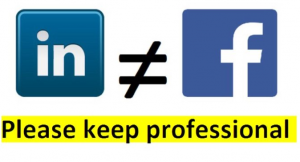Is LinkedIn the New Facebook?
LinkedIn these days seems to be less about posting “business” content and more around publishing selfies, memes and math puzzles.
Ironically, these Facebook-like posts generally get more traction. But all engagement is not always good engagement, just like all publicity is not always good publicity.
Interestingly enough, the Pew Research Center found that more workers ages 18-49 have discovered information on social media that lowered their professional opinion of a colleague, compared to those who garnered an improved estimation of a co-worker from online platforms. So, be careful what you post.
LinkedIn prides itself on “connecting the world’s professionals to make them more productive and successful.” What’s happened, however, is the line between “work” and “consumer” content has been blurred, causing LinkedIn professionals to lambast what they see as irrelevant posts, stating: “This is not Facebook!”
The reality is that LinkedIn is competing with Facebook. Late last year, Mark Zuckerberg’s social network announced it was testing a feature that would let page administrators create job postings and receive applications from candidates. This undoubtedly will put pressure on LinkedIn’s Talent Solutions business, which comprised 65 percent of the company’s 3Q 2016 revenues.
With 467 million members in over 200 countries and territories, LinkedIn, now owned by Microsoft, is growing at a rate of more than two new members per second. This quails in comparison to Facebook’s 1.79 billion monthly active users, but the company’s growth shows more professionals see value in the platform.
So what does the future look like for LinkedIn? Consider the following:
- LinkedIn will become an even more valuable business networking tool among business professionals, surpassing Pew’s estimate of the 14 percent of professionals who use the online platform for work-related purposes.
- “Irrelevant” posts will continue, at least in the short term, but will have an adverse effect on those who publish non-related content.
- Thoughtful, engaging and pertinent posts that resonate with key audiences will generate positive engagement.
- Business organizations and individuals will learn how to leverage this network beyond recruitment and job searches.
Much can be said by the old adage “all work and no play …,” so it’s refreshing to see some brevity in our daily work lives. But these matters may be best suited for Facebook and not LinkedIn.
— George Medici, gmedici@pondel.com






